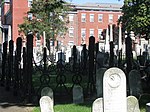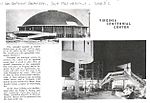Shockoe Hill African Burying Ground

The Shockoe Hill African Burying Ground (Richmond's 2nd African Burial Ground) was established by the city of Richmond, Virginia, for the interment of free people of color, and the enslaved. The heart of this now invisible burying ground is located at 1305 N 5th St. It was created as the replacement for the Burial Ground for Negroes, now also called the Shockoe Bottom African Burial Ground, (or African Burial Ground in Shockoe Bottom). Shockoe Bottom was known historically as Shockoe Valley. The Burial Ground for Negroes was closed in 1816 upon the opening of this new African Burying Ground on Shockoe Hill. The Shockoe Hill African Burying Ground is one of Virginia's most endangered historic places. Major threats to the burial ground are the DC2RVA high-speed rail project, the east-west Commonwealth Corridor, as well as the proposed widening of I-64, and various infrastructure projects.
Excerpt from the Wikipedia article Shockoe Hill African Burying Ground (License: CC BY-SA 3.0, Authors, Images).Shockoe Hill African Burying Ground
North 5th Street, Richmond Gilpin Court
Geographical coordinates (GPS) Address Website External links Nearby Places Show on map
Geographical coordinates (GPS)
| Latitude | Longitude |
|---|---|
| N 37.551805555556 ° | E -77.428388888889 ° |
Address
Shockoe Hill African Burying Ground
North 5th Street
23219 Richmond, Gilpin Court
Virginia, United States
Open on Google Maps









